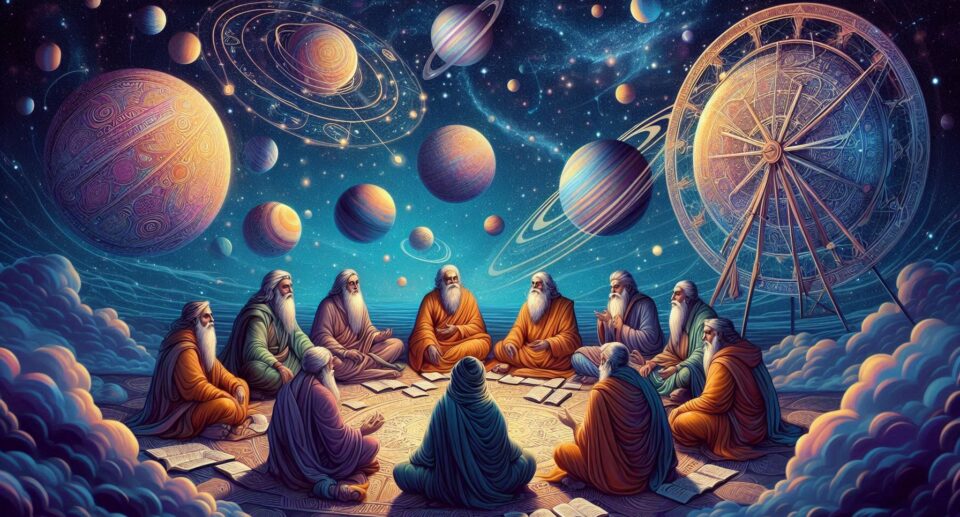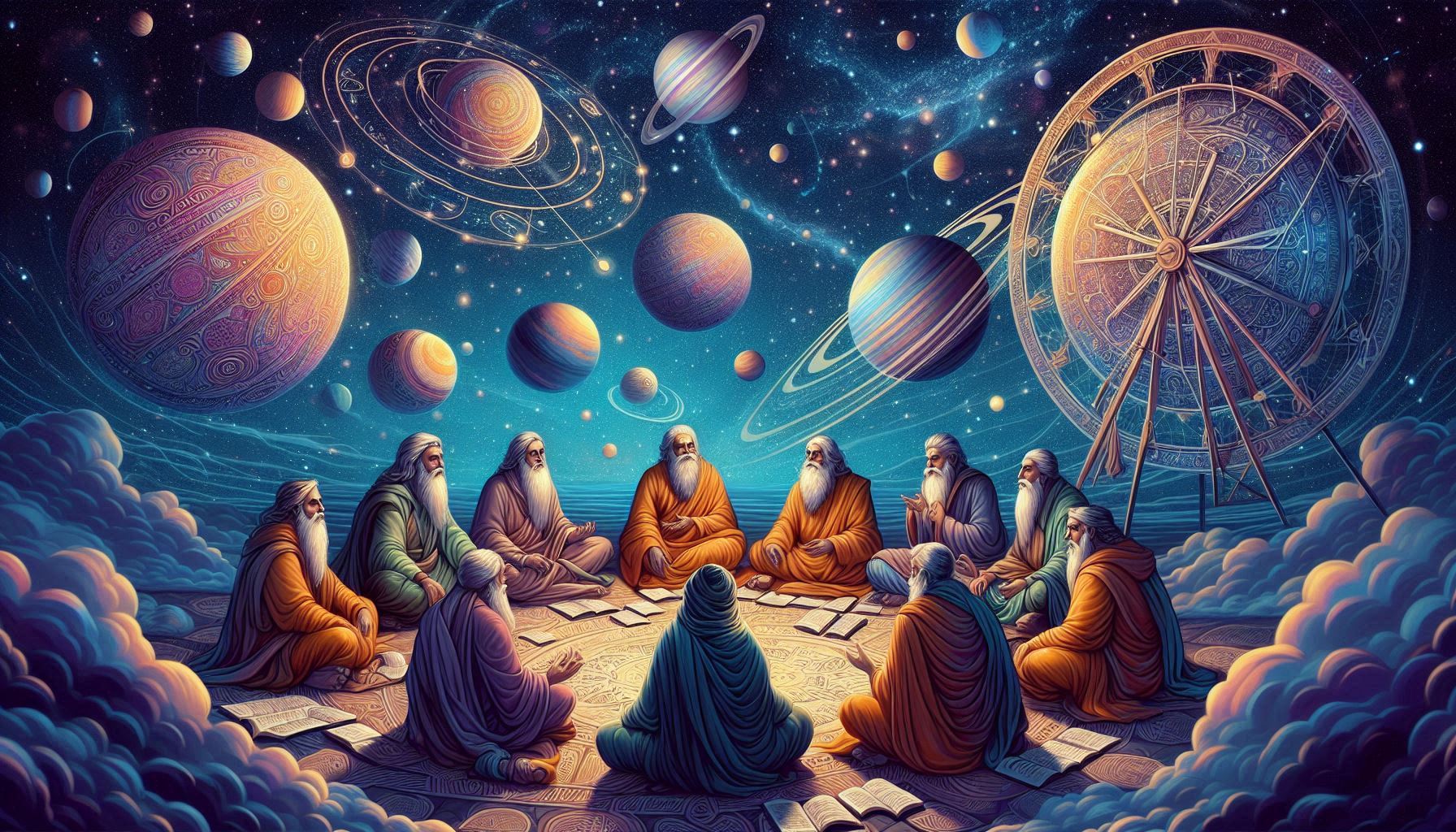When Bharatvarsha Led the World: Bharat’s Forgotten Vedic Heritage

While the West was still shrouded in myths and misconceptions, ancient Bharat was a beacon of scientific knowledge. Through profound meditation and yogic practices, the Vedic Sages delved into the mysteries of the cosmos and recorded their findings in intricate verses. These ancient texts, such as the Vedas, Nakshatra Kalpa, Puranas, and Shastras, contain remarkable scientific observations that predate modern Western discoveries by centuries.
A Glimpse into Cosmic Phenomena
The Vedas offer a comprehensive understanding of celestial bodies and their movements. For instance, they accurately describe the solar eclipse:
Verse:
यत् त्वा सूर्य स्वर्भानु स्तं अविध्यात् असुरः
अक्षेत्रवित यथा मुग्धो भुवनानि आदिधयुः (ऋग्वेद ५/४०/५)
(yat tvaa surya svarbhanu stam abidhyat asurah| aksetravit yatha mugdho bhuvanani adidhayuh)
Translation: O Sun, when you are eclipsed by the moon to which you have gifted your light, the Earth trembles in sudden darkness.
This verse clearly outlines the mechanics of a solar eclipse, a phenomenon later claimed by Western science as a novel research finding.

The Vedas stated that the Earth and other planets revolve around the Sun which was later claimed as the heliocentric model by the West:
Verse:
पञ्चरे चक्रे परिवर्तमने तस्मिं न तस्तूर भुवनानि विश्वा (ऋग्वेद १/१६४/१३)
(anchare chakre parivartamane tasmim na tasthur bhuvanani vishva)
Translation: The Earth and all other planets revolve around its axis and orbit the Sun.
This groundbreaking concept was proposed by ancient Bharatiya rishis (sages) long before it was even thought about in the West, where the geocentric model, placing Earth at the centre of the universe, was the prevailing belief.
The Sun’s Gravitational Force
The Vedic texts also recognize the Sun’s immense gravitational force, which holds the celestial bodies in their orbits:
Verse:
सविता यन्त्रैः पृथिवीं अरम्नाद असकम्भने सविता अद्रिम घाट
अश्वं इव अधुक्षन्धुनं अन्तरिक्षे अतुर्ते बधधां सविता समुद्रम् (ऋग्वेद १०/१४९/१)
(savita yantraih prithivim aramnad askambhane savita adrim ghat
ashvam iva adhukshandhunam antarikshe aturte badhdham savita samudram)
Translation: The Sun binds the Earth with a gravitational force, securely holding it and other planets in space with an unbreakable rope, like horses bound to a chariot.
This description is exactly what the modern understanding of gravity is, another claim by the West centuries later! While Western science tried to figure out why fruits fall down and not levitate in the air, ancient Bhartiya rishis (sages) had already understood Gravity and derived its significance.
The Moon’s Luminosity
The Vedas explain that the Moon derives its light from the Sun:
Verse:
सोमो बाधुर्युर् अभवत् अश्विनास् तं उभा बारा
सूर्यं यत्पत्ये शंसन्तिं मनसा सविता ददत (ऋग्वेद १०/८५/९)
(somo badhuryur abhavat asvinas tam ubha bara suryam yatpatye shansantim manasa savita dadat)
Translation: This verse gives the metaphor of the Moon as a bride and the Sun as a groom, where Savita (the Sun) bestows light on the Moon, proving that the Moon receives its light from the Sun.
This insight aligns with recent scientific observations, confirming that the Moon is a reflective body that shines by reflecting sunlight. While Western civilizations were still debating the nature of celestial bodies, ancient Bhartiya rishis had already arrived at accurate conclusions.
Day and Night: A Cosmic Dance
The Brihadaranyaka Upanishad offers a profound explanation for the occurrence of day and night:
Verse:
ताम यद अस्तं इति मन्यन्ते हैव तद् अस्तं इति आत्मनं विपर्यस्यते रात्रिम् एव
अवतं अथ यह पर तत् अथ यद एनस प्रातर उद इति इति मन्यते रत्रिर एव
अवतं अथ आत्मनं विपर्ययस्ये हर एव अवतं अथ यह पर तत् स हैव न कदचना
निमरोचति न ह वै कदाचना निमरोचति एतस्य ह साया…
(tam yad astam ititi manyante haiva tad astam itit atmanam viparyasyate ratrim eva avatam atha yah para tat atha yad enas pratar ud eti iti manyante ratrir eva avatam atha atmanam viparyasyate hara eva avatam atha yah para tat sa haiva na kadachana nimrochati na ha vai kadachana nimrochati etasya ha saaya…)
Translation: People believe the Sun sets, but this is not true. At sunset, the Sun is merely turning its rays away, creating night. When people think the Sun rises, it’s only that the Sun has turned its rays back, creating day.
This ancient text suggests that the Earth’s rotation, rather than the Sun’s movement, causes the day and night cycle. This understanding significantly advanced in ancient times, while geocentric and mythological explanations still dominated Western thought.

A Legacy of Wisdom
The Vedic scriptures offer a rich tapestry of scientific knowledge that continues to inspire awe and wonder. While much of this knowledge was lost over time, its rediscovery has shed light on the intellectual brilliance of ancient Bharatiya civilization. While the West was still grappling with basic scientific concepts, ancient Bharat was already exploring the depths of the cosmos and the intricacies of the natural world.
It’s time to reclaim our forgotten heritage and recognize the immense contributions of our ancestors to the field of science. Let us celebrate the brilliance of ancient Bharat and inspire future generations to delve deeper into the wisdom of the Vedas and other ancient texts.









